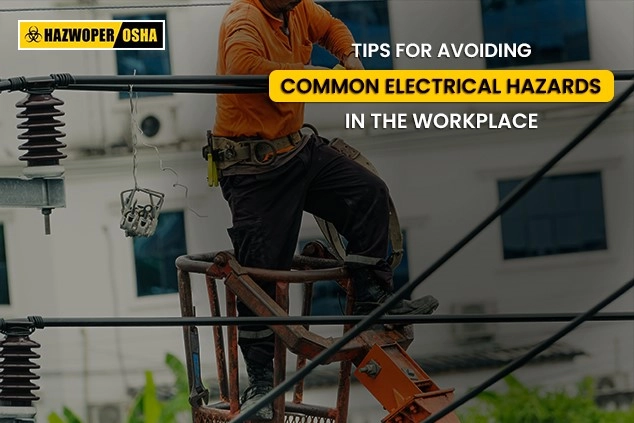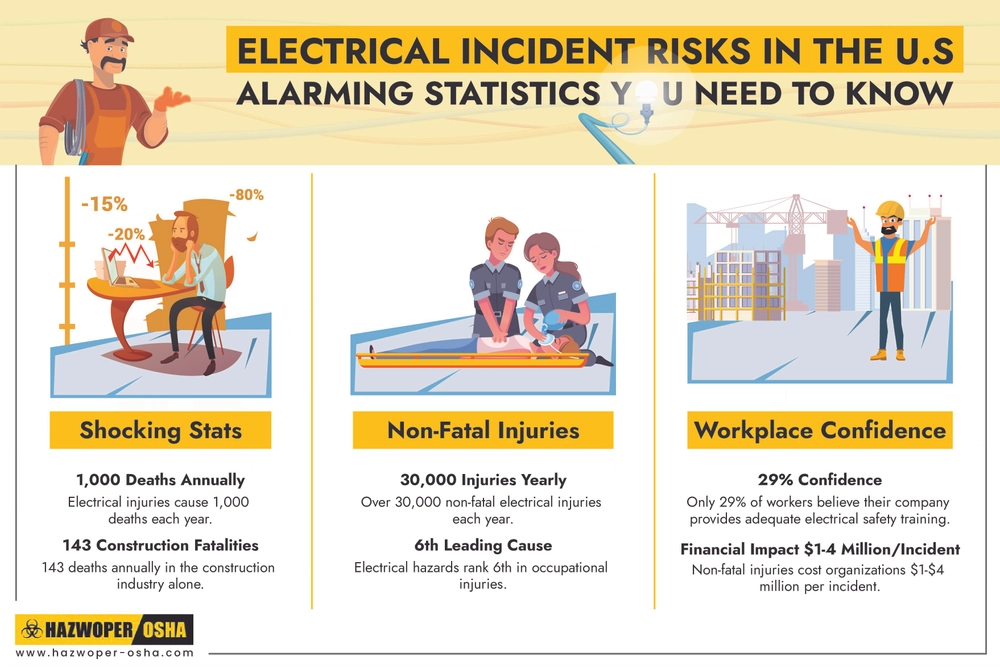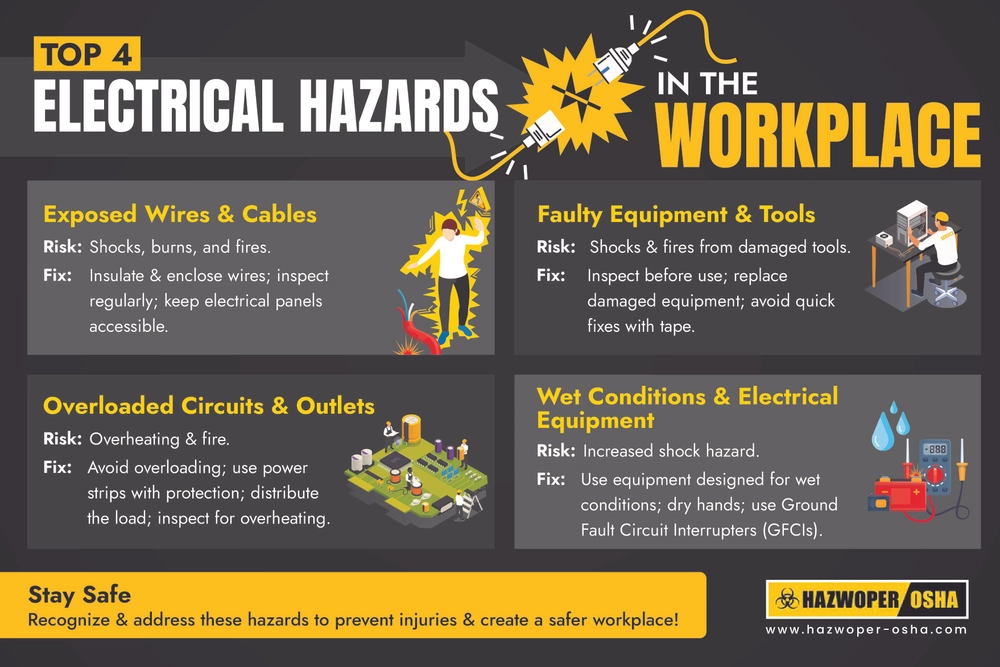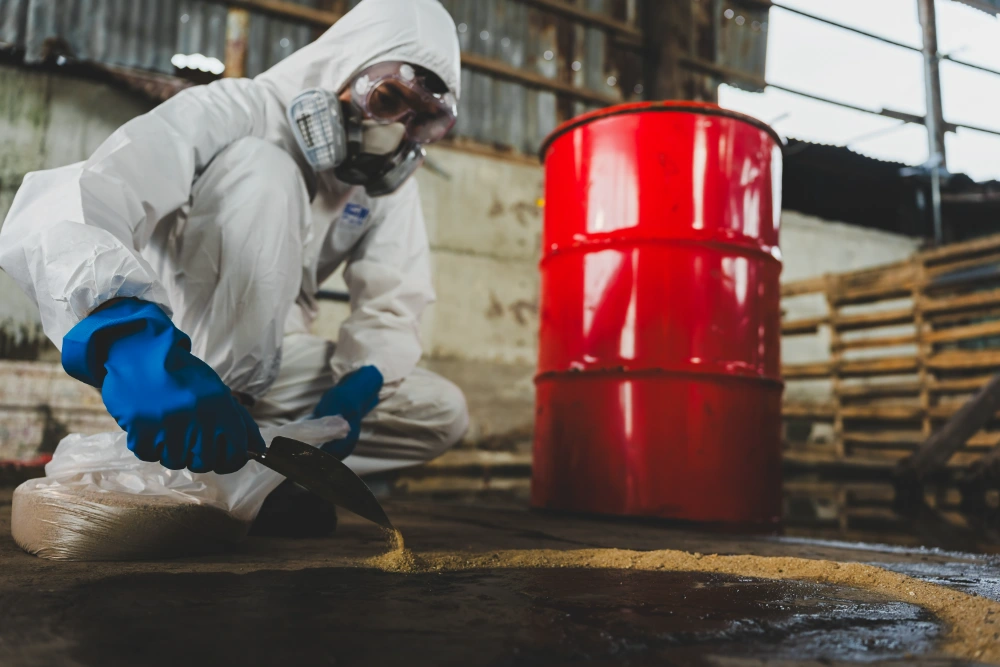Tips for Avoiding Common Electrical Hazards in the Workplace

Introduction:
In today’s fast-paced world, electrical systems are pertinent to enhancing productivity and efficiency but are also a serious threat. Each year, electrical incidents lead to many workplace injuries and fatalities. This is why protecting against electrical risks is a moral and legal duty of employers. This article will explain in depth the essential tips to avoid common electrical hazards in the workplace. From identifying the potential hazards to executing effective safety practices, employers can promote a culture of vigilance and safety and reduce the likelihood of accidents.
Statistics Related to Electrical Hazards
The electrical incident risks are significant, as the surprising statistics shed light on the condition of workplaces across the U.S. In 2023, electrical-related incidents were the number 1 cause of fatalities and injuries. Let's explore these statistics:
-Annually, 1000 people die from electrical injuries, with 143 fatalities in the construction industry.
-Every year, around 30000 non-fatal electrical injuries occur, shedding light on the severity of the issue.
-Electrical hazards cause about 4000 injuries annually, making electricity the 6th most common cause of occupational injury.
-Just 29% of workers are confident that their companies offer enough electrical safety training.
-Every year, non-fatal electrical injuries can cost between $1-$4 million/incident, affecting both the organizations and individuals financially.

Identifying Common Electrical Hazards
Following are the most common electrical hazards at the workplaces:
Exposed Wires and Cables
Exposed cables and wires are a major electrical hazard that can cause electrical shocks, fires, and burns if not addressed properly. Wires with damaged insulation can lead the electricity to arc to nearby metal objects and possibly cause fire incidents. If a worker accidentally contacts the exposed live parts, they can get a direct shock or a burn.
This hazard can be easily mitigated by properly insulating and enclosing all the electrical wirings in conduits and raceways. Inspect the wiring regularly at the workplace for signs of damage and deterioration and immediately replace the defective cords and cables. The areas around the electrical panels and junction boxes should be kept clear to keep visibility and easy access to these components.
Overloaded Circuits and Outlets
Outlets and overloaded circuits can overheat the wiring and start a fire, making them another common electrical hazard. The circuit's capacity gets overloaded by using too many high-wattage devices on a single circuit or using extension cords and power strips. This causes the wires to heat up on the brink of igniting the nearby combustible materials. To avoid overloading, use extension cords temporarily and do not plug in more devices than a circuit is rated for. Distribute the electrical load by installing additional outlets or circuits if required. Use the power strips with overcurrent protection, and don't daisy-chain them together. Regularly inspect the circuits for signs of overheating, such as burning odors and warm outlets.
Faulty Equipment and Tools
Broken, faulty, and worn-out electrical equipment and tools are a major shock and fire hazard. The equipment's outer metal part can get energized due to damaged insulation, poor grounding, and exposed live parts that cause electrical shocks. The internal components can get overheated and ignite nearby combustible materials. That is why one should always inspect the electrical equipment before using it. Check for signs of damage like frayed or cracked cords, loose connections, and missing ground pins. Never use defective equipment. Tag all the faulty equipment as out of service and get it repaired by a qualified electrician. Never put electrical tape to cover damaged insulation.
Wet Conditions and Electrical Equipment
Working in wet conditions with electrical equipment can increase the shock risks. This is because water is an excellent electricity conductor, and even a minute amount of moisture can energize the outer metal part of the equipment. Never use electrical equipment in wet conditions unless it is particularly designed for that purpose. Always dry out your hands before dealing with electrical devices. Always have a qualified electrician to ensure that the equipment is safe to use. When working with electrical equipment in wet areas, use ground fault circuit interrupters (GFCIs) to immediately cut off power if a ground fault happens.
The risk of injuries and fatalities in the workplaces can be reduced drastically simply by recognizing and addressing these common electrical hazards. Safer working environments can be created by providing the employees with comprehensive safety training, routine inspections and sticking to best practices regarding electrical safety.

How to Avoid Electrical Incidents in the Workplace?
By identifying and mitigating the electrical hazards in the workplace, employee safety and operational efficiency can be ensured. The likelihood of electrical incidents and accidents can be reduced by implementing safety practices. The following practices should be followed in the workplace to avoid electrical incidents:
- Stay at a safe distance from electrical currents greater than 50 V. Make sure all panel doors are shut off and your working area is free from any kind of exposed wires.
- De-energize and Use Lockout/Tagout for Equipment.: Before working with live electrical parts make sure they are de-energized. Isolate the electrical energy by applying the lockout-tagout procedures and avert their accidental activation.
- Always unplug the electrical cords with their plug head, don't overstretch them, and never fasten them with staples. Look out for any signs of damage in cords and plugs before using them.
- Use insulating physical barriers to protect the employees from electrical hazards. Always close the cabinet doors and use shields and insulating materials if needed.
- Never use conductive tools and cleaning materials around live electrical equipment.
- When working on ladders and elevated platforms, be cautious about overhead electrical lines. Keep a minimum distance of 10 feet from the exposed lines.
- Never operate electrical equipment in surroundings with flammable vapors or dust.
- Only trained and qualified personnel should be allowed to deal with live electrical wires to prevent accidents.
- Inspect electrical cords, devices, and plugs monthly and replace any faulty or worn-out parts immediately.
- Ensure enough electrical sockets are available to avoid overloading, which can cause fires.
- When working around electrical hazards, workers must be wearing non-conductive gloves, clothing and other safety equipment.
- Put clear signage to warn the employees of electrical hazards and keep them aware of the risks.
- Keep your employees updated on the electrical safety regulations and stay compliant to keep a safe working environment.
- Ensure employees are well-trained to deal with every type of electrical emergency. Make power switches easily accessible, and employees should know how to turn off the equipment in an emergency.
By sticking to these tips regarding common electrical hazards, employers and employees can ensure a safer workplace. These proactive measures can help save individual lives and boost overall productivity.
First Aid Required for Electrical Injuries
Every workplace must have adequate first aid to deal with electrical injuries, along with training employees to use it. When an electrical shock happens, secure the scene, turn off the electricity, and remove the source before touching the victim. Call the emergency services immediately if the person is unresponsive and do CPR on them. This is why CPR training should be a mandatory part of workplace safety programs, especially in high-risk environments.
For electrical burns, place the affected area under running water for at least 10 minutes to cool the burn. Then wrap it in a sterile bandage, and do not ice it. In the event of extreme injuries such as cardiac arrest or a major burn, it is better to get professional medical help immediately. Ensure the employees are trained to administer first aid and understand the specific protocols for dealing with electrical injuries.
The first-aid kit for electrical injuries should contain the following items:
- Burn dressings to soothe and secure the burns.
- Hydrogel-based burn gel to moisturize and cool off the burn.
- Cold Packs for swelling and pain relief.
- Sterile gauze pads and bandages to cover and secure the burn.
- Microporous tape to secure the dressing.
- Nitrile Gloves to ward off infections.
- Scissors for cutting bandages, tapes, and other materials.
- Painkillers for pain management.
- Wound dressing for wrapping severe burns.
Lastly, make sure to replenish the kit regularly and train the employees to use it. A simple first-aid kit at the workplace will save lives and reduce the severity of injuries.
Employee Training and Awareness Regarding Electrical Hazards at Workplace
An effective electrical safety program is incomplete without updated employee training and awareness. An electrical safety program should include:
- Topics like standard methods of using electrical equipment.
- Recognizing potential hazards like exposed wires and overloaded circuits.
- Emergency procedures regarding electrical incidents.
In addition, the training must include personal protective equipment use and safety practices. This is why we, HAZWOPER OSHA Training LLC, offer Electrical Safety Training (NFPA 70E), a course covering all the regulatory requirements of safety regarding electrical hazards. To cater to the diverse needs of employees, this course is available online, onsite, instructor-led, and in SCORM formats. So, why wait? Visit our website, enroll, and get certified.
Conclusion:
Protection against electrical hazards is a critical aspect of keeping the workplace safe and meeting the regulatory requirements. Any workplace can become risk-free simply by identifying common electrical hazards, executing stringent safety practices, employee training and having a well-maintained first aid kit. Remember an electrical accident can take many lives within seconds and cause hefty financial losses. Invest in your workplace safety today and upgrade your safety standards.
References:
Cleango, 6th March 2024, 54 Electrical Accidents & Workplace Injury Statistics, https://www.bookcleango.com/blog/electrical-injury-statistics
Safety Evolution Blog, 23rd April 2023, Identifying Electrical Hazards In Construction: Tips For Risk Assessment, https://www.safetyevolution.com/blog/identifying-electrical-hazards-in-construction

 EN |
EN |  ES
ES

































































































































